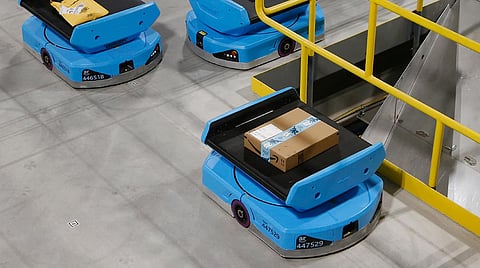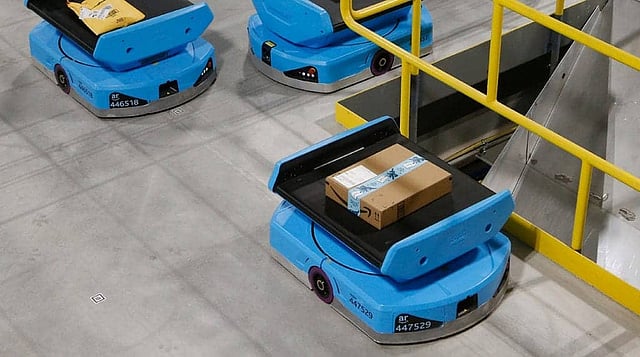
- Insights
- Cryptocurrencies
- Stocks
- White Papers
- Industry
- Geography
- Insights
- Cryptocurrencies
- Stocks
- White Papers
- Industry
- Geography


The absolute greatest names in artificial intelligence, including two godfathers of the machine learning boom, are wagering that clever algorithms are going to change the capacities of industrial robots. Geoffrey Hinton and Yann LeCun, who shared the current year's Turing Prize with Yoshua Bengio for their work on deep learning, are among the AI illuminating presences who have invested resources into Covariant.ai, a startup creating AI innovation for warehouse bin-picking bots.
Covariant has now left stealth mode and is reporting its work with Knapp, a major provider of warehouse logistics technologies today. Its algorithms have just been deployed on Knapp's robots in two of Knapp's clients' warehouses. One, handled by the German electrical provider Obeta, has been completely in production since September. The co-founders state Covariant is additionally close to hitting another deal with an industrial robotics giant.
Covariant claims its bots can do what others can't: work 24 hours every day, picking things without whining. This doesn't imply that picking is a tackled issue. Covariant's robots utilize suction cups not robotic fingers, making the task simpler. Yet, it unlocks a great deal of potential. This is especially valid in the realm of warehouses and logistics, where experts state it's hard to discover human workers and they need all the robots they can get.
A lot of this publicity has been created by the promise of machine learning. Today's industrial robots can pick with extraordinary speed and accuracy, however, only if what they're getting is similarly predictable: customary shapes with easy-to-grasp surfaces. That is fine in manufacturing, where a machine needs to hold a similar item again and again, yet horrible in retail logistics, where the objects being stuffed for shipping fluctuate immensely in shape and size.
Hardcoding a robot's every move, similarly with conventional programming, works extraordinary in the first situation yet awfully in the second. In any case, if you use machine learning to sustain a system information and let it create its own principles on the most proficient method to pick instead, it does a whole lot better.
Getting ordinary boxes and plastic packages may sound trifling, and it is for most people. Laborers in manufacturing plants and warehouses are regularly given new objects to deal with, or a bunch of various things combined, however, it's misleadingly hard for a machine to rapidly turn out how to get the next doodad. Workplace robots are still extraordinarily imbecilic and cumbersome, and instructing them to get a handle on new items or those with complex shapes stays a holy grail of AI and robotics research.
Lately, various organizations have jumped up offering robots that utilize less complex algorithms to perform valuable warehouse tasks, including limited product picking. Fruitful players incorporate Plus One Robotics, Picnic, and RightHand Robotics.
More secure robot arms, custom grippers, off-the-rack sensors, and open source code for robot vision and control have made it simpler for new companies to deploy robots in new jobs, for example, shipping items around warehouses or taking boxes off pallets.
There are two types of tasks in warehouses: things that require legs, such as moving boxes from the front to the rear of the space, and things that require hands, such as getting things and putting them in the perfect spot. Robots have been in warehouses for quite a while, however, their prosperity has principally been constrained to automating the former type of work. Moving stuff between the fixed points is an issue that mechatronics is extremely incredible for.
Yet, automating the movements of hands requires something other than the correct hardware. The innovation should agilely adapt to a wide variety of product shapes and sizes in ever-evolving orientations. A customary robotic arm can be programmed to execute the equivalent precise movements over and over, yet it will bomb the minute it experiences any deviation. It needs AI to "see" and change, or it will have no expectation of staying aware of its advancing environment. It's actually the skill part that requires intelligence.
Covariant uses a scope of AI procedures to show robots how to get a handle on new products. These incorporate reinforcement learning, wherein an algorithm trains itself through experimentation, similar to the manner in which creatures learn through positive and negative feedback.
Reinforcement learning has driven awesome recent breakthroughs in AI, including the superhuman game-playing algorithms created by Alphabet's AI subsidiary, DeepMind. The methodology can enable a robot to make sense of what shape an item is from a video picture and where to grasp it, regardless of whether it has just been trained on objects of an alternate shape. This might be done in simulation with the goal that the procedure can be accelerated.
Demand for robots is commonly developing at a rapid clip, as per the International Federation of Robotics, an industry body. It says that 422,000 robots were deployed in 2018, a 6% increase over 2017, with establishments of more intelligent, progressively collaborative robots increasing 23% over a similar period. The IFR additionally anticipates an average development of 12% for all robots somewhere between 2020 and 2022.
Covariant.ai has already intrigued some seasoned players in robotics technology. A year ago, the Swiss-Swedish robotics technology monster ABB started looking for organizations to assist it with moving into warehouse automation. It sent Covariant.ai and different organizations boxes of articles for their frameworks to try to pick in a controlled experiment. Marc Segura, worldwide head of service robotics at ABB, says Abbeel's organization was the only one ready to pick everything over and over.
For all the certainty, investor and otherwise, Covariant's operation is inconceivably small at the present time. It has only a bunch of robots in activity full time, in America and abroad, in the clothing, pharmaceutical, and electronics enterprises. In Germany, Covariant's picking robot (there's only one for the time being) is packing electronics components for a firm named Obeta, yet the organization says it's excited for more robots to make up for a staff lack, a circumstance normal in logistics.
